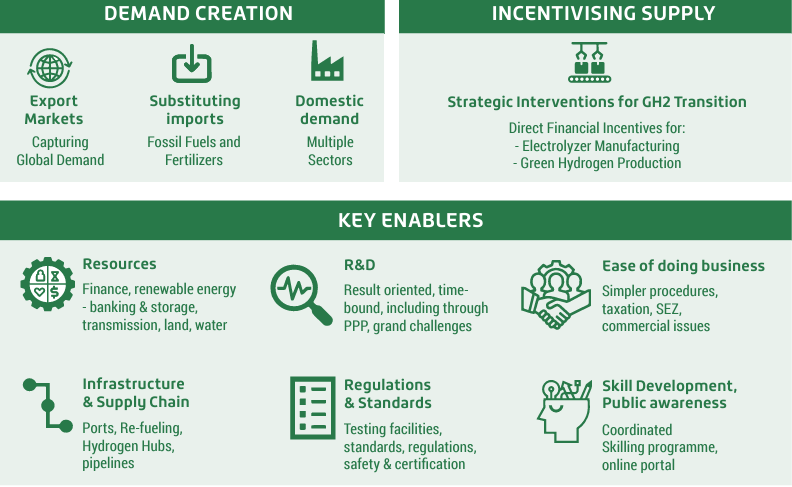National Green Hydrogen Mission
National Green Hydrogen Mission
The National Green Hydrogen Mission has been approved by the Union Cabinet on 4th January 2023.
Objectives
The overarching objective of the Mission is to make India the Global Hub for production, usage and export of Green Hydrogen and its derivatives. This will contribute to India’s aim to become Aatmanirbhar (self-reliant) through clean energy and serve as an inspiration for the global Clean Energy Transition. The Mission will lead to significant decarbonisation of the economy, reduced dependence on fossil fuel imports, and enable India to assume technology and market leadership in Green Hydrogen.
Budget outlay
The Mission has an outlay of Rs 19,744 crore. The initial outlay for the Mission will be Rs.19,744 crore, including an outlay of Rs.17,490 crore for the SIGHT programme, Rs.1,466 crore for pilot projects, Rs.400 crore for R&D, and Rs. 388 crore towards other Mission components.
Outcomes
The Mission will result in the following likely outcomes by 2030:
- Development of green hydrogen production capacity of at least 5 MMT (Million Metric Tonne) per annum with an associated renewable energy capacity addition of about 125 GW in the country
- Over Rs. Eight lakh crore in total investments
- Creation of over Six lakh jobs
- Cumulative reduction in fossil fuel imports over Rs. One lakh crore
- Abatement of nearly 50 MMT of annual greenhouse gas emissions
Implementation
Considering the nascent status of the sector and the rapidly evolving profile of the industry, the mission is proposed to be implemented in a phased manner, focusing initially on deployment of Green Hydrogen in sectors that are already using hydrogen, and evolving an ecosystem for R&D, regulations and pilot projects. The later phase of the Mission will build on these foundational activities and undertake Green Hydrogen initiatives in new sectors of the economy. The major thrust areas of each phase are identified below.
Phase I (2022-23 to 2025-26)
The focus of Phase I will be on creating demand while enabling adequate supply by increasing the domestic electrolyser manufacturing capacity. In order to ensure Make in India from the inception stage, a bouquet of incentives aimed at indigenization of the value chain and increasing Green Hydrogen production and uptake will be developed. Utilisation in the refineries, fertilizers and city gas sectors will also create a sustained demand to support new investments in Green Hydrogen production.
The first phase will also lay the foundation for future energy transitions in other hardto-abate sectors by creating the required Research and Development impetus. In this phase, pilot projects will be undertaken for initiating green transition in steel production, long-haul heavy-duty mobility and shipping. Parallelly, work will commence on establishing a framework of regulations and standards to facilitate the growth of the sector and enable harmonisation and engagement with international norms.
The scale up of Green Hydrogen production and use, and the proposed measures under the Mission in the first phase, are expected to drive down costs, allowing for greater and wider Green Hydrogen deployment in the next phase.
Phase II (2026-27 to 2029-30)
Green Hydrogen costs are expected to become competitive with fossil-fuel based alternatives in refinery and fertilizer sector by the beginning of the second phase, allowing for accelerated growth in production. Depending upon the evolution of costs and market demand, the potential for taking up commercial scale Green Hydrogen based projects in steel, mobility and shipping sectors will be explored. At the same time, it is proposed to undertake pilot projects in other potential sectors like railways, aviation etc. R&D activities will be scaled up for continuous development of products. The second phase activities would enhance penetration across all potential sectors to drive deep decarbonisation of the economy.
Mission Components
The achievement of Mission objectives requires a comprehensive strategy that coordinates efforts across multiple sectors. The Mission strategy accordingly comprises interventions for:
- demand creation by making Green Hydrogen produced in India competitive for exports and through domestic consumption.
- addressing supply side constraints through an incentive framework, and
- building an enabling ecosystem to support scaling and development.

The Mission will facilitate demand creation, production, utilization and export of Green Hydrogen. Under the Strategic Interventions for Green Hydrogen Transition Programme (SIGHT), two distinct financial incentive mechanisms – targeting domestic manufacturing of electrolysers and production of Green Hydrogen – will be provided under the Mission. The Mission will also support pilot projects in emerging end-use sectors and production pathways. Regions capable of supporting large scale production and/or utilization of Hydrogen will be identified and developed as Green Hydrogen Hubs.
An enabling policy framework will be developed to support establishment of Green Hydrogen ecosystem. A robust Standards and Regulations framework will be also developed. Further, a public-private partnership framework for R&D (Strategic Hydrogen Innovation Partnership – SHIP) will be facilitated under the Mission; R&D projects will be goal-oriented, time bound, and suitably scaled up to develop globally competitive technologies. A coordinated skill development programme will also be undertaken under the Mission.
All concerned Ministries, Departments, agencies and institutions of the Central and State Governments will undertake focussed and coordinated steps to ensure successful achievement of the Mission objectives. Ministry of New & Renewable Energy will be responsible for overall coordination and implementation of the Mission.
To access the complete Mission document, click here.
Source : MNRE
Last Modified : 5/17/2024
India's shift to "Green Steel" may depend on the d...
The Government has decided to grant waiver of Inte...
Provides information about Green Hydrogen Policy
The National Hydrogen Mission aims to aid the gove...
